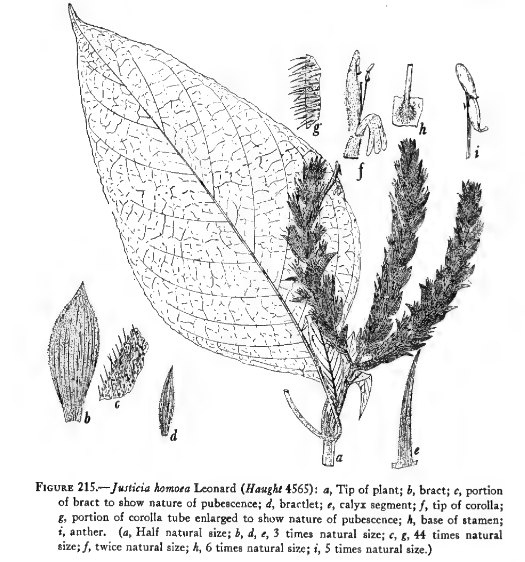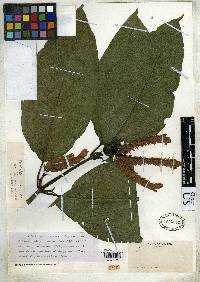
Neotropical Flora
|
Family: Acanthaceae
|
Slender shrubs up to 2 meters high; stems subquadrangular, the angles rounded, minutely and antrorsely strigose, the hairs up to 0.2 mm. long, golden brown; leaf blades oblong-ovate, up to 26 cm. long and 11.5 cm. wide, short-acuminate, subobtuse at base, firm, undulate or shallowly and indistinctly crenate, both surfaces glabrous except the costa and lateral veins, these conspicuous especially beneath and sparingly strigose, the hairs up to 0.24 mm. long, the veinlets delicately reticulate beneath, the cystoliths numerous and con- spicuous under a lens, up to 0.32 mm. long; petioles up to 4 cm. long and 2.75 mm. thick, minutely strigose with yellowish hairs; flowers borne in dense axillary and terminal spikes, these borne in pairs or in threes, up to 10 cm. long and 13 mm. thick, the bracts quadrifarious, the peduncles about 1 cm. long, these and the rachis subquadrangular, densely hirtellous with yellowish ascending straight rigid hairs up to 0.2 mm. long; bracts slightly obovate, 11 mm. long, 4.25 mm. wide slightly above the middle, acute, sessile, strongly parallel-nerved (4 to 6 pairs of lateral nerves), rather densely puberulous with erect straight glandular subpapillate hairs up to 0.03 mm. long and bearing toward tip a few additional ascending eglandular hairs up to 0.24 mm. long, the inner surface essentially glabrous, the margins ciliate with hairs about 0.16 mm. long; bractlets similar but smaller (6.5 mm. long, 2 mm. wide); calyx 1 cm. long, the segments linear-lanceolate, 8.5 mm. long, 1.5 mm. wide, the pubescence similar to that of the bracts and bractlets; corolla rose color, 2.3 cm. long, densely and retrorsely hirtellous with rigid hairs up to 0.16 mm. long, the tube rather narrowly cylindric, 2.5 mm. broad at base, narrowed at 5 mm. above base to 1.5 mm., thence enlarged to 2 mm. at the throat, the lips subequal, 8 mm. long, the upper lip erect, oblong-ovate, about 4 mm. wide near base, 1 mm. wide at tip, rounded, the lower lip strongly recurved, cuneate, about 6 mm. wide at base of the lobes, these 3, ovate, 3.5 mm. long, the middle one 2 mm. wide, the lateral ones slightly narrower, all rounded; stamens reaching tip of the upper lip of the corolla, the filaments flat, glabrous except the auriculate base, the auricles densely pilose with straight spreading whitish hairs about 0.32 mm. long, the anthers 3.5 mm. long, 0.75 mm. broad, glabrous, the cells superposed and vertically attached to the connective, the cells about equal in length, the lower one caudate, the tail about 0.75 mm. long and 0.25 mm. wide, rounded at tip; style exserted about 5 mm. beyond the mouth of the corolla tube, glabrous toward tip, hirtellous toward base, the stigma minute, subcapitate; ovary glabrous except the hirsute tip, the hairs ascending, up to 0.32 mm. long, capsules not seen. Type in the U. S. National Herbarium, No. 1995082, collected in wet forest southeast of Chigorodo, 40 km. south of Turbo, Depart- ment of Antioquia, Colombia, 50 meters altitude, April 15, 1945, by Oscar Haught (No. 4565). Justicia homoea has the same habit and general appearance as J. phlebophylla Leonard (Haught, No. 4564); in fact, plants of the two species were growing in the same colony. Both are slender shrubs 2 meters high, with large, almost glabrous, veiny leaves bearing numer- ous conspicuous cystoliths. The spikes of the two species are, how- ever, definitely dissimilar. Those of J. homoea have oblong, slightly obovate, strongly nerved bracts up to 11 mm. long and 4.25 mm. wide and the flowers are 4-ranked; in J. phlebophylla the flowers are secund and the bracts are ovate and 3 mm. long and 1.5 mm. wide. The corolla of the latter is purple, marked with light lines; that of J. homoea is rose color. The specific epithet is from the Greek word potos, meaning similar, in allusion to its resemblance to J. phlebophylla. |
Powered by Symbiota.



